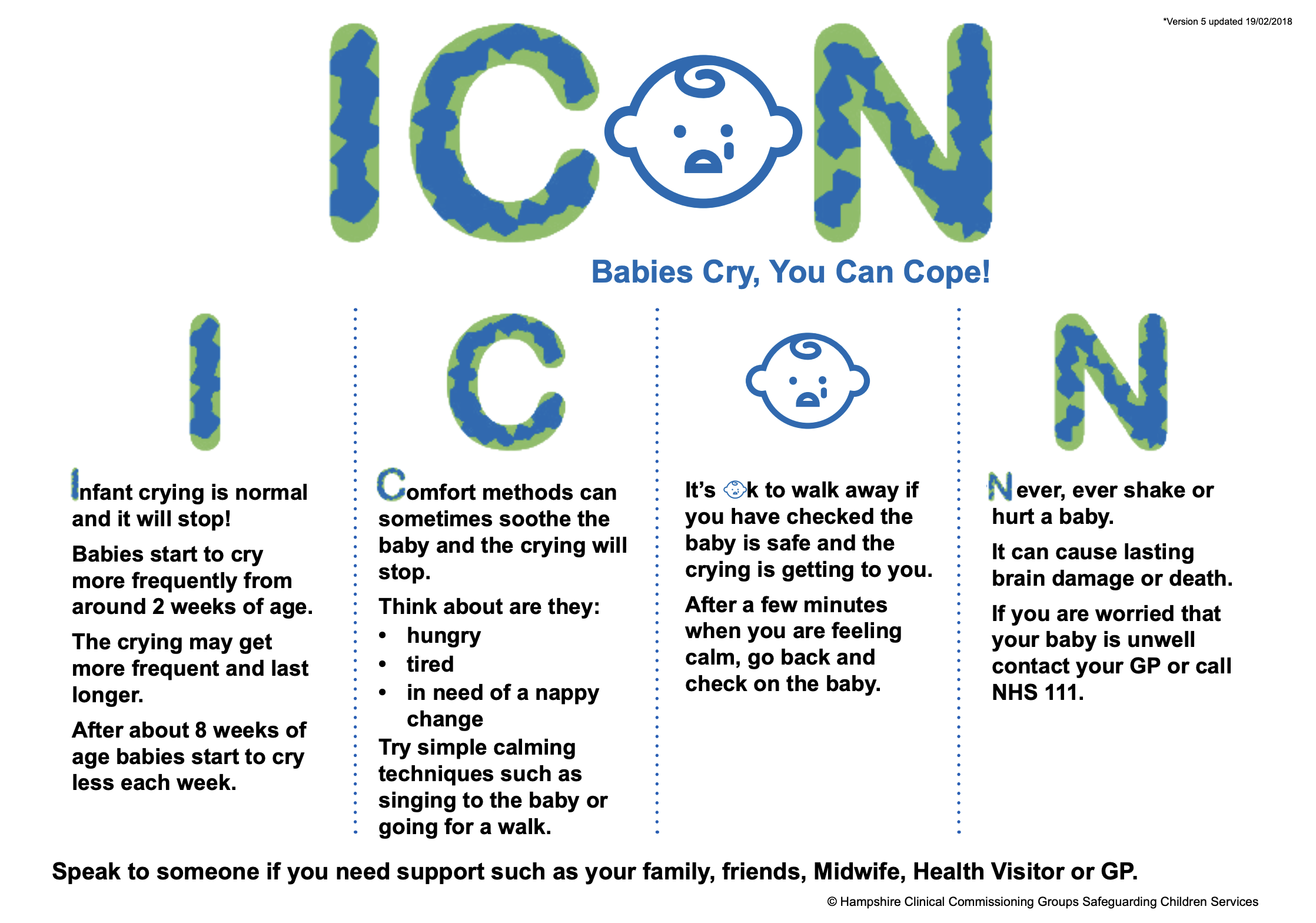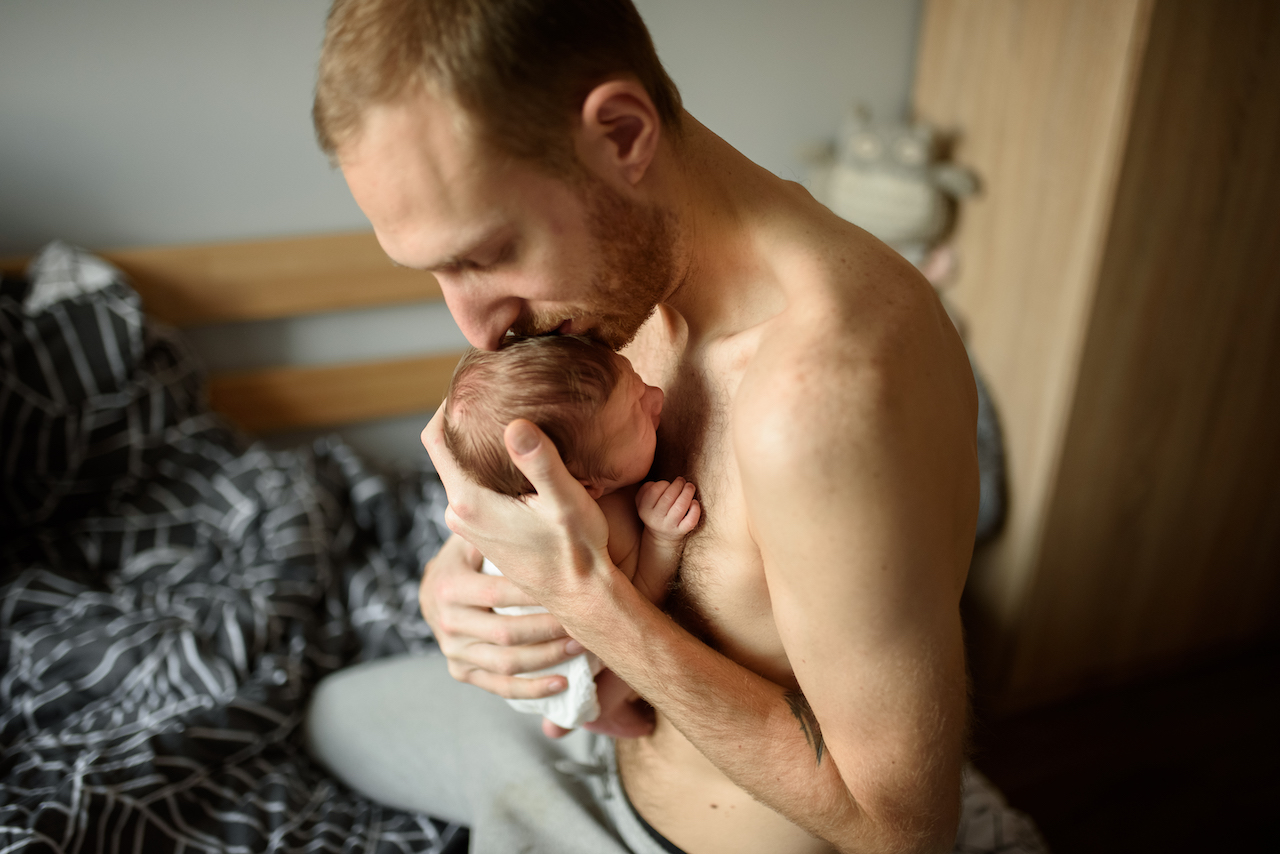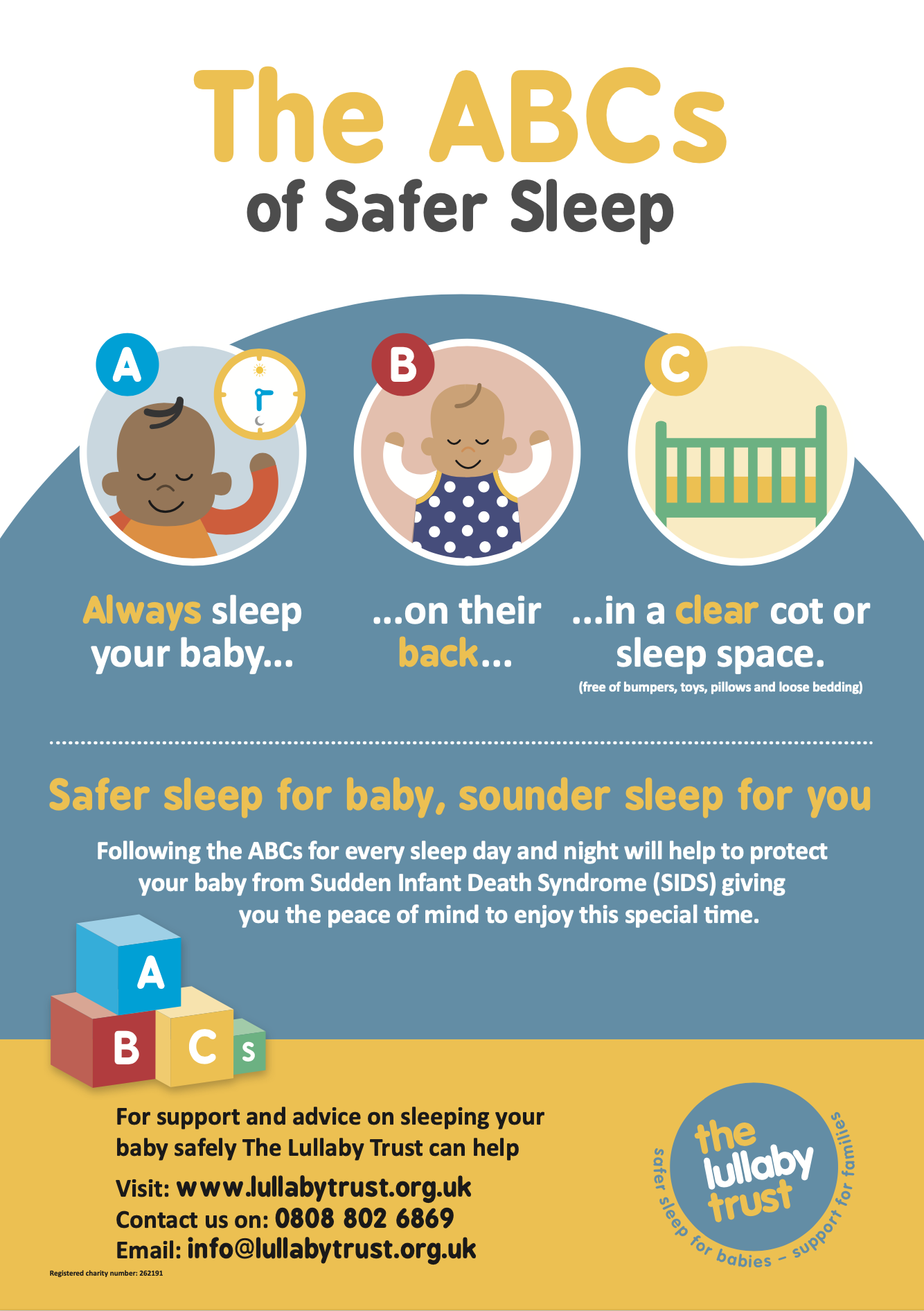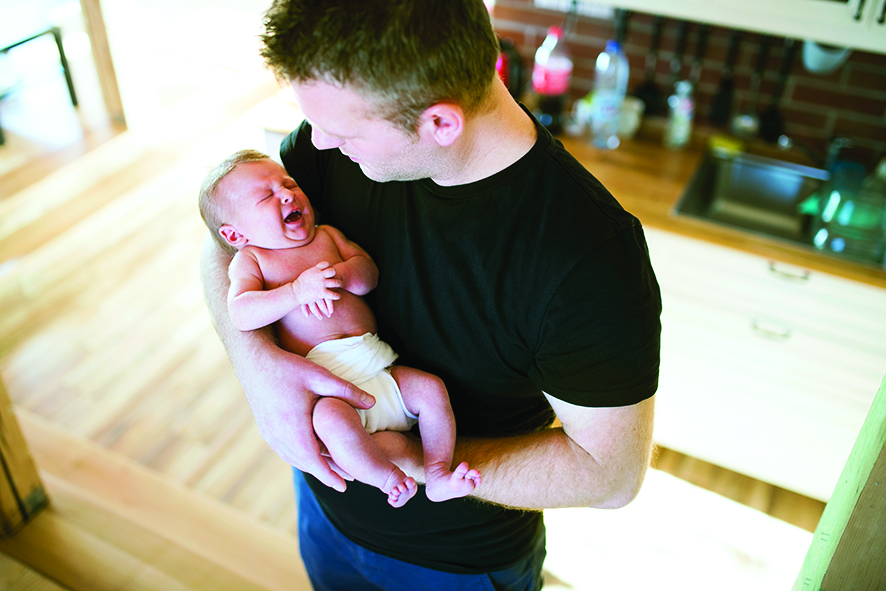
Ask DadPad, Crying, Parenting Advice
Ask DadPad: How do I cope with my baby’s crying?
Posted on 1st October 2021
This week – running from 27 September until 1 October – is the first ever ICON Week, which aims to raise awareness of infant crying and how the ICON message can help parents and carers to cope.
Here at DadPad, we’re delighted to be able to team up with the amazing team behind the ICON message in order to help them share their work far and wide. The information that we provide within DadPad and the DadPad app on coping with crying is all based on the ICON message:

Why the ICON message is so important
Last year, we spoke with Dr Suzanne Smith, founder of and programme advisor for ICON and we asked her to give us an overview of what ICON is about and how it works:
ICON: Babies cry, you can cope is a programme delivered by a variety of health professionals to parents and carers of new babies. The aim of the programme is to educate parents, support them to cope with a baby that is crying and to understand that all babies start to cry more from about 2 weeks of age, reaching a peak at about 6-8 weeks and gradually subsiding by 4-5 months of age. Our aim is that, by helping parents cope with crying, it will help prevent Abusive Head Trauma in babies which we know is often triggered by a parent who loses control with a crying baby and shakes them.
This latter point is crucial, not least in the light of the recently-published “The Myth of Invisible Men” Report from The Child Safeguarding Practice Review Panel which identified “the potential impact of crying as a precipitating factor of non-accidental injury to small children” [para 11.8]. This is especially important for new dads to be aware of, given that “evidence suggests that males are responsible for inflicting Abusive Head Trauma due to shaking in approximately 70 per cent of cases… However, depending on the research paper, this figure can fluctuate anywhere between 60 and 90%. (Jones, 2020, para 1.2) and that “[m]any of the cases appeared to arise… ‘out of the blue’…” (Jones, 2020, para 1.1). This means that all of us need to be mindful of the fact that infant crying has the potential to become an extremely stressful and frustrating situation for us to deal with, and that we all have the potential – in a moment of lost control – to do something that we will later come to regret.
So what can we do to minimise the chances of that happening within our own family?
Understanding more about infant crying
Perhaps the hardest thing when caring for your baby is to learn to cope with their crying. Remember, though, that all babies usually cry for a reason – it’s their way of communicating, and a pretty successful way of getting your attention! Try not to panic or worry that you’ve done something wrong; instead, try and work out what they’re trying to tell you. Obviously, you can’t ask them but you can look for clues, and also try things, to see what works.
Some key things to check for with a crying baby are:
- HUNGER – how long is it since baby had a feed? Are they demonstrating any feeding cues (things like mouth opening, lip licking and hand sucking)?
- UNCOMFORTABLE – does baby need their nappy changed? This is where you get to ‘enjoy’ that infamous parental activity: the ‘bum sniff’ – we’ve all done it! With both fabric and disposable nappies, you can also get a good idea from their weight whether they’ve been weed in.
- TIRED – does baby need a nap?

All of these common reasons for crying are easily remedied, and hopefully checking each of these this will stop the crying.
Other reasons to look and listen out for, though, include:
- in pain – you’ll know this cry when you hear it!;
- feeling poorly – e.g. a tummy ache;
- feeling really poorly – as with the cry of pain, you should be able to spot this one without any doubt. Always act on your instinct if baby’s cry is noticeably weak, or will not stop, or is combined with other symptoms that are not normal for them;
- feeling frightened – new sights and sounds might easily startle baby; or
- just a bit unsettled and in need of a cuddle.
Although, to start with, all cries might sound the same, you will soon find – especially as you get to know your baby and their individual personality – that you become better at working out what they need.

However, on some occasions, no matter how hard you try, you might feel as though nothing is helping. Depending on your circumstances, it might be an idea to put baby in their pram or the sling and go for a walk, or strap them in their car seat and go for a drive. Often, the change of scenery or the soothing motion can help to settle baby down. You could also try singing to baby (they won’t care whether you’re any ‘good’ or not – they will just enjoy hearing your voice), play them some soothing music, cuddle them in different positions (including trying skin-to-skin), or gently rock baby in your arms. As you become more experienced as a dad, you will get to know what works best for your baby.
It’s also worth letting you know about something called the ‘crying curve’ or the ‘period of purple crying’, because – at certain stages in their early life – babies will cry a lot, and often there’s no reason for this. Not many people know about this, but Dr Suzanne Smith explained it when we spoke with her last year:
Research shows that all babies start to cry more from 2 weeks. It reaches a peak at 6-8 weeks and starts to gradually reduce. There may be a reason for the crying… [but sometimes] the baby cries for no apparent reason and it can be really frustrating and upsetting for parents who think they are doing something wrong... Knowing about [this normal peak of crying] helps parents cope with it because they know it might not be anything they are doing wrong and they know it will pass.
Coping with crying
If you ever feel yourself getting angry, frustrated or cross with baby, however, you need to take positive steps to calm down. Don’t ever take out your anger on your baby – shouting at them will only upset them more, and (as we’ve noted above) shaking or rough-handling can cause real, serious and irreparable damage to baby’s body and brain, and even death. This is where the ICON message comes into play.
The ICON message
The ICON message is a relatively simple one, with four key points:
- Infant crying is normal and the crying will stop.
- Comfort methods will sometimes help and the crying will stop.
- It’s OK to walk away for a few minutes if the baby is safe and the crying is getting to you.
- Never ever shake or hurt a baby.
We’ve already considered the first couple of points above, but it’s worth adding – in relation to trying to comfort your baby – a comment from Dr Suzanne Smith:
The thing is that some things work sometimes and not others. You might think you’ve cracked it but it doesn’t work next time you try it. It can be really frustrating but it is important to stay calm. Let someone else take over if you are getting exhausted and frustrated – that doesn’t make you a failure; it means you are a responsible parent.
It’s OK to walk away…
The next two parts of the ICON message are really important to keep in mind when you feel that you are beginning to lose control (for this reason, you might want to have a copy of the ICON message somewhere visible where you would commonly be caring for baby – e.g. in baby’s bedroom – just in case you need a reminder at a key moment).
The “it’s OK to walk away” message is important as it gives us – as new parents – permission to recognise when our reserves are becoming depleted and/or we can tell that our growing irritation is interfering with the way that we are interacting with and caring for our baby.
What you need to do in this situation is firstly make sure that baby has been placed somewhere safe, where they can come to no harm. The best example would be their cot or normal sleep space, ensuring that all the usual advice regarding safe sleep practice has been adhered to (i.e. lying on their back, with nothing else in the cot).

When you are certain that baby is safe, you can then walk away. Take yourself off to another room for a few minutes (staying in the same room, listening to them crying, really won’t help you), and try and find some way of distracting yourself, perhaps by popping on some headphones and listening to some calming music, making yourself a cup of tea and/or taking a few deep breaths. You might also want to follow Dr Smith’s suggestion of calling a friend or family member and asking them to come round.
After a few minutes, go back and check on your baby. Hopefully, in just that short space of time, you’ve been able to gather yourself back together and can get back to giving your baby the gentle, loving care it needs.
Importantly, never worry or feel ashamed about walking away for that short period of time, if you feel that you need to. As Dr Suzanne Smith noted: “It happens to all of us who are exposed to a crying baby after a while and it is normal… Getting angry with your baby is not going to help and will make things worse, so when that feeling starts to rise, you are not being less of a parent by checking your baby is safe and walking away to calm down for a few minutes. It’s OK!”.
DON’T SHAKE!
The final element of the ICON message is – of course – to NEVER shake or hurt your baby. Dr Smith said:
We know that most babies who are shaken are shaken because parents/carers have become frustrated with their baby’s crying. The damage caused by shaking a baby is not well understood by everyone who may think they are not causing much damage. But it can very quickly cause major brain injury, bleeding behind the eyes and bone injuries.
Reaching out for support
If you find yourself really struggling with your crying baby, though, on an ongoing basis, there are some great resources and helplines available – we’ve listed some of these below. You could also try talking over your worries with someone that you trust, such as a friend or another family member, and don’t forget your Health Visitor. They won’t judge you, and will have lots of ideas on how to cope; after all, you’re not the first and you won’t be the last parent to raise this issue with them. Coping with a crying baby is hard, especially when combined with the sleep deprivation that also comes hand-in-hand with having a newborn baby, but it is all a normal part of being a parent and it won’t last forever.

Sharing the message
The ICON team are keen to ensure that all parents and carers of a baby are aware of their message – after all, anyone left alone with a crying baby has the potential to become distressed and/or angry and then to lose their self-control. Dr Suzanne Smith told us that the ICON team “…encourage parents to share the [ICON] information with everyone who will be caring for their baby because not all babies who are shaken are shaken by their parents.”
Focusing on dads
Further, because the statistics do indicate that most (though not, of course, all) babies who are shaken are shaken by men, ICON have aimed a lot of their social media and resources at being relatable to men and dads, including this ‘I am Unshakeable’ video:
As a new dad, you may find that this period of your life – coping with all the major life changes and anxiety, alongside a lack of sleep and the what-often-feels-like relentless crying – can be especially challenging and you may find yourself becoming more angry or irritable than you have before. If that is the case, then you need to be especially mindful of that, and take positive steps to deal with it because – as we’ve noted in this blog – the potential consequences could be horrific. We’d recommend you have a quick read of a blog post that Julian wrote last year, which looked at anger management and control. We’ve also listed below the same links that we shared in that original blog to some potentially useful resources if you feel that you might need a bit of help in dealing with your anger and remaining calm.
Final word
We’ll end this blog with a final word from ICON’s Dr Suzanne Smith about her team’s aims:
Our hope is that, by providing more parents and carers with the information about coping with crying and also by raising awareness of the dangers of shaking a baby, more people will recognise what is happening when they start to lose control, will remember the ICON message, and will walk away and calm down.
Key dos and don’ts when coping with a crying baby:
DO:
- Remember that all babies cry, as their means of communicating with the world
- Listen and observe, to help understand what might be causing her to cry
- Take safe, sensible steps to calm down when you need to do so. Put baby in a safe place (e.g. her cot) and take yourself to another room for a few minutes
- Remember that you cannot ‘spoil’ baby by offering her cuddles and comfort when she is crying. They will often be the best way of soothing her and stopping her crying
DON’T:
- Get cross or angry with baby for crying – shouting at her will only upset her more
- EVER shake your baby – this could cause serious, long-lasting injury, or even death
- Be afraid to ask for help – speak to someone you trust for help and advice. Your Health Visitor is a great place to start.
- Ignore a cry of pain, or where you feel that something really is wrong with baby. Parental instinct is usually right – seek immediate help if you feel that baby is poorly.
Links to useful resources:
As well as providing advice on coping with crying on their website, CRY-SIS also operate a telephone helpline, from 9.00am-10.00pm, seven days a week (08451 228669).
The ICON Cope webpage sets out key advice and information for new parents struggling to cope with their crying baby. Their parents’ advice webpage contains links to short YouTube videos with ideas on ways to cope, to keep calm and to relax.
The British Association of Anger Management‘s website includes lots of useful information, podcasts and blog posts on anger and anger management, as well as free online tests.
The NHS Anger webpage also includes lots of useful information on symptoms of anger, key dos and don’ts, and a mood self-assessment.
Finally, the Mind mental health charity website has a page dedicated to anger and anger management, including sources of support for those who feel that they may need additional help with their anger problems.
References and Further Reading:
The Child Safeguarding Practice Review Panel (2021). “The Myth of Invisible Men” – Safeguarding children under 1 from non-accidental injury caused by male carers. [online]
Jones, Kim (2020). Hampshire ICON Evaluation Report 1 year on. Hampshire Safeguarding Children Partnership/NHS West Hampshire Clinical Commissioning Group. [online]
DadPad blog post (Jun 2020). Ask DadPad: How do I care for my baby?
DadPad blog post (Oct 2020). Q&A: Dr Suzanne Smith from ICON
DadPad blog post (Dec 2020). Ask DadPad: How do I keep calm?!
DadPad blog post (Mar 2021). Ask DadPad: How do I keep my baby safe while they sleep?

